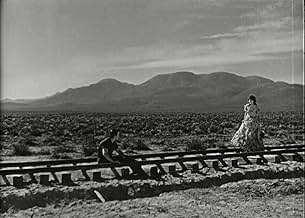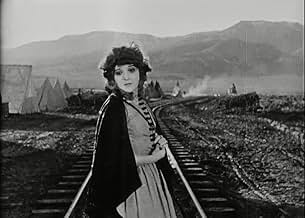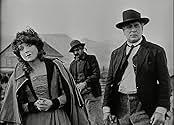Après avoir assisté, enfant, au meurtre de son père par un renégat, Brandon, devenu adulte, aide à réaliser le rêve de son père, à savoir la construction d'un chemin de fer transcontinental.Après avoir assisté, enfant, au meurtre de son père par un renégat, Brandon, devenu adulte, aide à réaliser le rêve de son père, à savoir la construction d'un chemin de fer transcontinental.Après avoir assisté, enfant, au meurtre de son père par un renégat, Brandon, devenu adulte, aide à réaliser le rêve de son père, à savoir la construction d'un chemin de fer transcontinental.
- Réalisation
- Scénario
- Casting principal
- Récompenses
- 2 victoires au total
- Cpl. Casey
- (as J. Farrell Macdonald)
- Pvt. Schultz
- (as James Welch)
- …
- Buffalo Bill Cody
- (as George Wagner)
- Judge Haller
- (as James Marcus)
- Cheyenne Chief
- (non crédité)
- Indian
- (non crédité)
- Worker
- (non crédité)
- Worker
- (non crédité)
- Minor Role
- (non crédité)
- Rail Worker
- (non crédité)
Avis à la une
"The Iron Horse" is indeed an impressive silent epic western of John Ford. Of course this western is flawed, with excessive patriotism, subplots and running time of 150 minutes. But considering the limited and primitive technical resources in 1924, it is amazing how the director could have made, for example, the scene of the stampede or the Cheyenne attack. Further, there are unusual angles of camera and the take from below the train arriving to save the workers is sensational in the prime cinema that used huge cameras. The plot seems to be based on the true story of the two North-American transcontinental railroads and the lead story of Davy, Miriam and her father is engaging. My vote is eight.
Title (Brazil): "Cavalo de Ferro" ("Iron Horse")
The Western itself of course went through many developments in theme, and can be grouped into different phases. The Iron Horse, along with Covered Wagon, Three Bad Men (1926) and The Big Trail (1930) belongs squarely to the "pioneer" Westerns which dominate this era. In these pictures the west would typically be an unclaimed wilderness, and the heroes were those who explored, settled and developed it. By now the genuine old west was fading from living memory, and so now we had the first generation for whom it could be a romanticised piece of history. Plus of course there is the fact that the wagon trails, railroads and cattle drives of the pioneer Western were ideal for the aforementioned fashion for epic pictures.
Today of course The Iron Horse is best remembered for its director a young John Ford. Even back then Ford had a close association with the Western, although to some extent his style is still in development here. His shot composition relies heavily on very distinctive framing devices such as tree branches or posts, and sometimes the shots look a little cluttered. Also, his approach to the romantic love scenes is entirely conventional with close-ups, rhyming angles and sparse backgrounds so as to focus on the actors. The older (more cynical?) John Ford tended to shoot these moments rather flatly, the camera hanging back, and even throwing in distracting background business.
On the other hand, and perhaps in ways that matter more, this is very much the same John Ford of Stagecoach, Fort Apache and so forth. In particular is his vision of the west. Right from the opening scenes he contrasts the smallness of the homestead with the romantic allure of the wilderness framing the actors tightly in the opening shots, and then cutting to point-of-view shots of the trail. He always captures the vastness of the outdoors, and yet without ever dwarfing the people in it. Particularly impressive (and this is perhaps where Ford's greatest strength lay) is his ability to combine different storytelling elements in a single shot for example at one point we see a mother mourn her son at his grave in the foreground, while a heavily loaded train passes through in the background.
Another typically Fordian element is the precedence he gives to the comic relief characters. On location they were largely working without a script, so Ford could spin their scenes out as long as he wanted. As with many of his later pictures, charming though it is, the comedy business threatens to unbalance the real story. We can also see in "Drill ye terriers" a forerunner to the group singsong that is a staple of even the earliest John Ford talkies.
A nod to the actors is also due. This was George O'Brien's first lead role and he doesn't do badly, considering he got the part mainly for being a good-looking newcomer who could ride a horse. He doesn't emote too convincingly, but he moves well which is the most important thing for a picture like this. The other standout is J. Farrell MacDonald, who played the kind of roles for Ford in the silent era that would later be filled by Victor McLaglan in the talkies basically a comical Irish drunk. But like McLaglan he hid real dramatic talent under the act, and he emerges as the most genuine player in this piece.
Ford's confidence and passion for the genre make the Iron Horse a classic, but it's worth remembering that The Iron Horse is also a triumph of post-production. Cast and crew had gone on location without a complete shooting script and large chunks of it are more or less improvised. As well as directing Ford took one of his earliest credits of producer and, would thus have been able to continue supervising the product after shooting was over. It's hard to imagine what any other producer or editor would have made of the footage he brought back from location. It's unlikely they would have kept so much of the comic diversions and "oirishness", and it's perhaps with The Iron Horse that we have - for better or for worse - the earliest example of an unbridled John Ford.
Bursting with excitement & patriotic fervor, THE IRON HORSE is the film which put young director John Ford on the cinematic map. He brought together all he had learned from years of making shorter, smaller films and he produced a product which heralded his enormous contributions to sound films in the years to come. This is a `director's picture' in that the stars, as good as they are, are almost negligible; what was important here was Ford's vision & his ability to place it before the audience. Indeed, he does not even bring his leading man (George O'Brien) on screen until 45 minutes into the story - a shortcut to disaster almost anywhere else.
(In all fairness it should be noted that O'Brien, handsome & strong-limbed, does very well as the gentle hero. He would find similar roles in other epic films of the decade. J. Farrell MacDonald, as Irish Corporal Casey, is the prototype for many comically eccentric fellows who would appear in other Ford westerns.)
The film often takes on the aspects of an ancient newsreel. Cattle drives, Indian attacks & endless track laying all look utterly real. Particularly fascinating is the depiction of the dismantlement of the end-of-the-track town, so that not even a dog is left, as it is moved many miles further on to the west. This type of arcane information is what makes watching very old films so enjoyable.
THE IRON HORSE represented the largest migration out of Hollywood for location shooting up to that time. Nothing like this had been attempted before, so Ford & his lieutenants were forced to make up the rules as they went along.
Hiring a circus train, the small army of extras arrived at the subzero Nevada location in January of 1924. The conditions which greeted them were authentically primitive. It was so cold, the extras quickly began sleeping in their costumes. Finding the train to be flea ridden, they moved into the sets and began living exactly as the characters they were portraying. The female extras especially suffered from the rugged conditions. A frontier mindset seemed to take over many of the cast & crew; the circus tent, which doubled as both the movie saloon and the crew's commissary, eventually had to have the catsup bottles removed from the tables to discourage the many fights which kept breaking out.
Authenticity found its way into the movie in other, more positive, ways. Several of the elderly Chinese extras, representing laborers on the Central Pacific, had actually worked on the real McCoy sixty years previous. They came out of retirement to appear in the film & enjoyed themselves immensely. Ford also managed to locate the two original locomotives which met at Promontory Point, Utah, in 1869 and reunited them for the film's climax.
Composer John Lanchbery has contributed a splendid soundtrack to the restored video version, incorporating several contemporaneous tunes of the period. It would be intriguing to double bill THE IRON HORSE with Cecil B. DeMille's UNION PACIFIC (1939), which tells the same historical story, but with a completely different tack & set of fictional characters.
Le saviez-vous
- AnecdotesThe kitchen staff for the film was made up largely of Chinese cooks. Some of them had been workers on the transcontinental railroad in 1869, the same construction project that forms the basis of this film.
- GaffesThe locomotives and rolling stock use knuckle-type couplers, which did not begin wide use until the 1890s. In the 1860s-era setting of this movie, the couplers in use would have been link-and-pin. This anachronism is understandable as the safety issue would have prohibited the use of the era-appropriate link-and-pin couplers.
- Citations
Thomas Marsh: [after Brandon, Sr. leaves to go west to pursue building a transcontinental railroad] Poor dreamer - he's chasing a rainbow!
Lincoln: Yes, Tom - and some day men like you will be laying rails along that rainbow.
- Versions alternativesThe DVD release of this film contains two different edits, one for the American market and one for Europe. The American release is 16 minutes longer than the European cut. The American cut is dedicated to the memory of Abraham Lincoln while the European release is dedicated to the memory of George Stephenson. In the American release Fred Kohler's character is named Deroux while in the European cut his character is named Bauman.
- ConnexionsEdited into The Story of Our Flag (1939)
- Bandes originalesBlow the Man Down
(uncredited)
Traditional 19th Century Sea Chanty (1860s)
[Integrated into restoration score into divorce and going back to work scenes]
Meilleurs choix
- How long is The Iron Horse?Alimenté par Alexa
Détails
Box-office
- Budget
- 450 000 $US (estimé)
- Durée
- 2h 30min(150 min)
- Mixage
- Rapport de forme
- 1.33 : 1


































